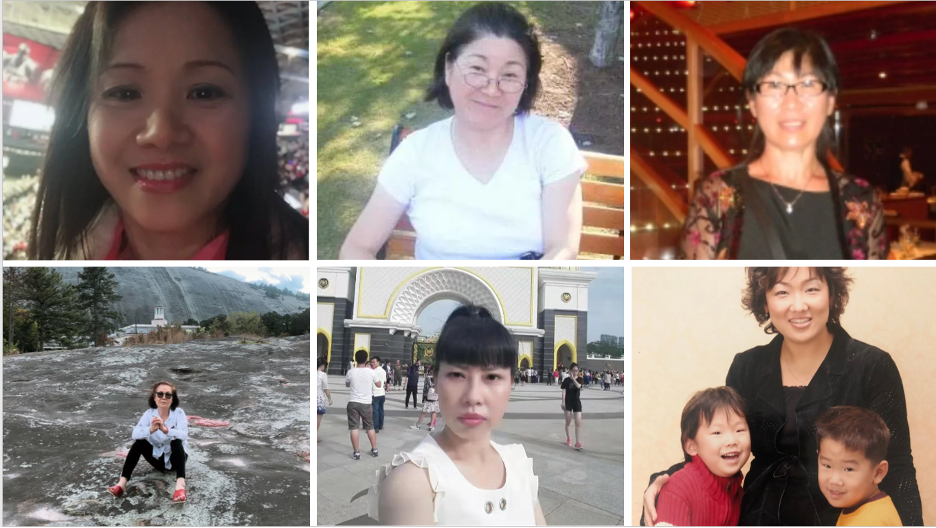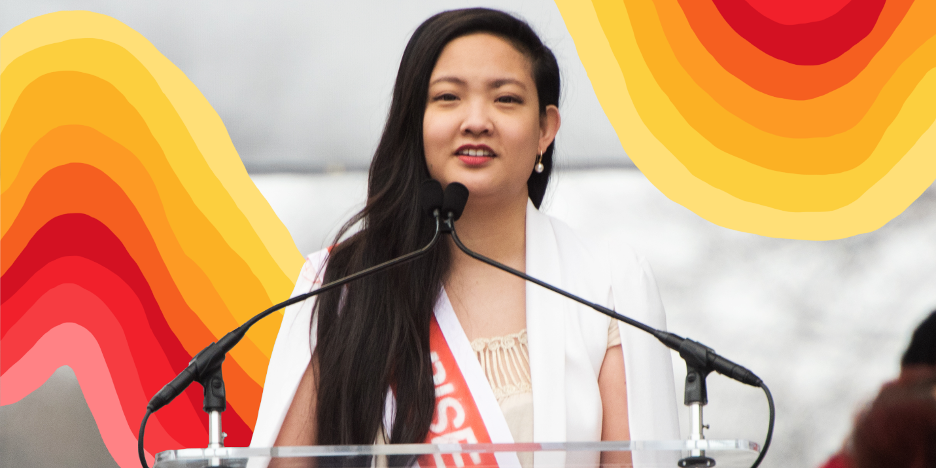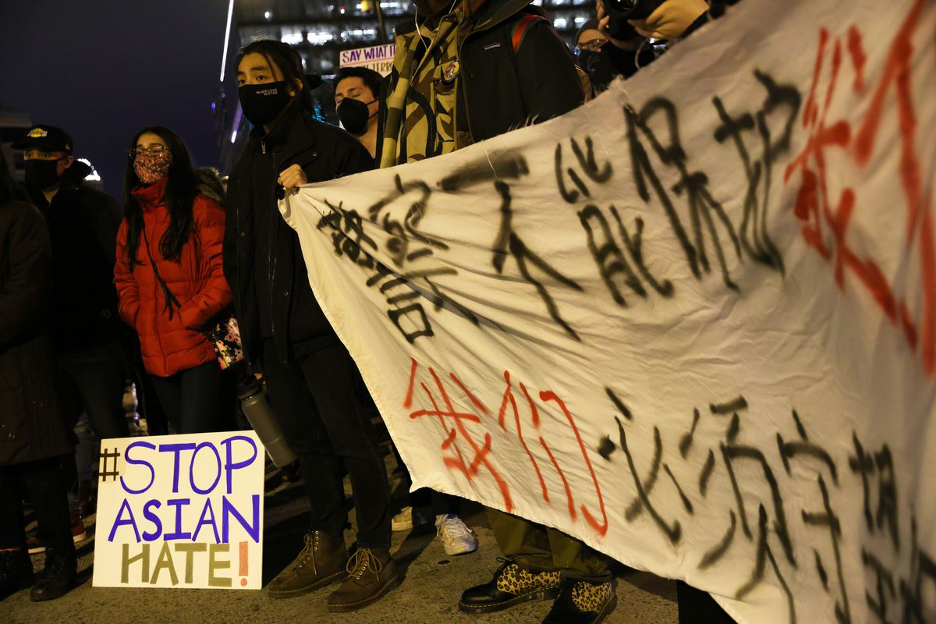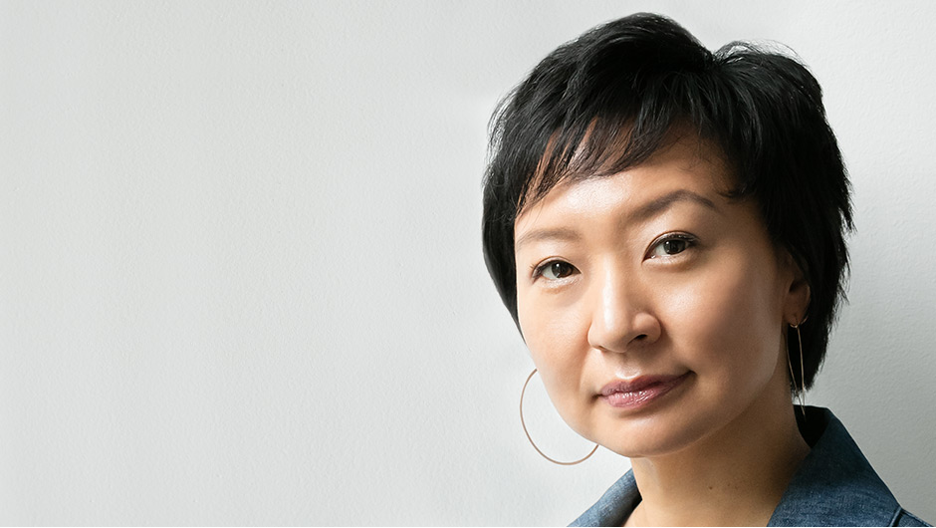Kristina Arevalo
 As an Asian American woman, a Filipina American, the COVID-19 pandemic has been heart-wrenchingly difficult. Fear was in the air for many—fear of catching COVID, fear of dying from COVID, fear of our loved ones getting sick, but for many Asian Americans there was another type of fear. The pandemic brought on something familiar, a fear of being discriminated against, fear of being targeted, fear for our friends and family, fear of being killed for just daring to exist. In her incredible book Minor Feelings, author Cathy Park Hong writes, “minor feelings: the racialized range of emotions that are negative, dysphoric, and therefore untelegenic, built from the sediments of everyday racial experience and the irritant of having one’s perception of reality constantly questioned or dismissed” (p. 55). Fear is a minor feeling.
As an Asian American woman, a Filipina American, the COVID-19 pandemic has been heart-wrenchingly difficult. Fear was in the air for many—fear of catching COVID, fear of dying from COVID, fear of our loved ones getting sick, but for many Asian Americans there was another type of fear. The pandemic brought on something familiar, a fear of being discriminated against, fear of being targeted, fear for our friends and family, fear of being killed for just daring to exist. In her incredible book Minor Feelings, author Cathy Park Hong writes, “minor feelings: the racialized range of emotions that are negative, dysphoric, and therefore untelegenic, built from the sediments of everyday racial experience and the irritant of having one’s perception of reality constantly questioned or dismissed” (p. 55). Fear is a minor feeling.Some may try to argue that anti-Asian hate is new, created by Trump when hebegan referring to COVID-19 as the “China virus” or the “kung flu.” But Asian Americans know that exclusion, invisibility, discrimination, and dehumanization are all part of our history dating back to the 19th century. To understand anti-Asian hate, we have to know the true history of Asian America, not the watered-down version that we are taught in our history classes.
The dehumanization and exotification of Asians in America began with the first recorded Chinese woman to arrive in the US in 1834—nineteen-year-old Afong Moy, who was advertised as a “beautiful Chinese lady.” She was brought by two traders who brought back Chinese goods to New York and was used to promote their goods. She toured the East Coast and people bought tickets to see her “exhibit.” For 8 hours a day, Afong Moy would be on display to watch her walk in Chinese clothes and bound feet, use chopsticks, and speak Chinese. Her existence was a spectacle, a performance, for the white gaze. She was seen as exotic, but, inferior. This was the beginning of the dehumanization of Asian women; this kind of experience has continued to persevere well into the modern day, as we saw with the tragic murders in Atlanta in March 2021. I will never forget how I felt that day and the weeks to follow. I was scrolling through Twitter before bed when the news broke about the Atlanta Spa Shootings, I felt my heart clench, my stomach drop, and the tears wouldn’t stop coming. During this time, I was writing up my Master’s thesis on anti-Asian discrimination during COVID and I couldn’t get anything done. I had so much rich data on all the awful experiences that Asians have been going through during the pandemic: verbal harassment—being shouted at by store employees, by people in cars when they were walking down the street, physical harassment—having rocks thrown at them, and so many other things that absolutely broke my heart. I couldn’t write, I couldn’t focus, this familiar feeling of fear kept building up inside of me.
Asian Americans have been systemically erased from history books and media, and this invisibility has cost us our humanity in exchange for the continued regard for white humanity. Daoyou Feng, Hyun Jung Grant, Suncha Kim, Soon Chung Park, Xiaojie Tan and Yong Ae Yue—six Asian women; how horrifying that these women had to die at the hands of a young white man who saw Asian women as temptation. Any time the news spoke about this horrible event, they focused on how he, the murderer, was feeling, what his grandparents thought. A police captain had said “yesterday was a really bad day for him,” blaming his sex addiction as the problem. I know I’m not the only Asian girl who has had guys ask her for a “happy ending,” or been told by a white guy that they have “yellow fever.” We know how race, gender, and class intersect, we’ve lived through these experiences and these Asian women were being erased. This feeling of inferiority and invisibility was resurfacing, nobody cares cause they’re Asian, I thought. These Asian women were the objects of exotification, devoid of their own voice and power, subjected to the same white gaze as Afong Moy.
The 1875 Page Act was passed soon after Afong Moy’s disappearance, all records of her existence vanished in 1850. The Page Act barred Asian womenfrom immigrating to the US. Because Asian women were stereotyped as promiscuous and as prostitutes, this law prohibited immigration from “China, Japan, or any Oriental country,” explicitly forbidding the “importation into the United States of women for the purposes of Prostitution,” and those who were not brought of their own free and voluntary consent. These hypersexualized stereotypes continued into WWII with the military creation of “rest and recreation sites,” in Asian countries. History has shown that these stereotypes continue to harm Asian women as we’ve seen in the Atlanta shootings and the amplified discrimination Asian women have faced AAPI women have faced during the pandemic. This experience is referred to racialized sexism and sexualized racism. There was much discussion on whether the Atlanta shooting was motivated by race or sex, but it was actually both. Sexualized racist violence has been a part of American history, more than those like to admit. A specific part of history that is not often taught is the military sex slavery system created by Imperial Japan in the 1930s. They called them “comfort women” and Japanese Imperial Army used comfort stations to “boost morale” and blow off steam. These girls (as young as 12) and women were kidnapped, many orphaned or from poor communities, and forced to work in military brothel’s known as “comfort stations.” The US military system repurposed this system after WWII and established their own “camp towns” in the 1940s across Asia. Stereotypes of Asian women being submissive and sexually subservient persist as a 2002 study found an overrepresentation of Asian women as rape victims on thirty-one pornographic websites. These stereotypes continue to harm us, physically, verbally, and psychologically.
During the 19th century, Chinese and South Asian men began to migrate to the Latin Americas, the West Indies, and parts of the US as indentured servants. Many were kidnapped, coerced, or deceived, and they were treated harshly, exploited, and abused. They became stereotyped as “coolies,” cheap laborers who drive down wages and steal jobs. Their growing numbers incited hate and fear among white Americans. Sound familiar? These stereotypes continue to shape the perception of immigrants today. Asian people have been living in this country for generations, but we still get treated like foreigners in our own home. Asian people have been blamed for the pandemic, we’ve been told to “go back to your own country,” physically and verbally assaulted on the streets, and murdered in hate crimes. There were even calls for bans of Chinese students from Texas Universities by GOP candidate Shelley Luther. This is not the first time Asians have been scapegoated in the US. In 1894, an outbreak of the bubonic plague hit Honolulu where doctors believed that the disease only affected Asian people, they locked down Chinatown’s and quarantined Asian people while letting white people freely roam. When a white teenager died of the disease, they moved to more extreme measures, burning down any building where a victim had died, eventually all of Chinatown was destroyed. Months later, a Chinese immigrant in San Francisco died from the plague, government officials restricted only Asian immigrants from traveling in and out of California, locked down Chinatown for 3 days, and burned any property that came into contact with the plague. The belief that Chinese Americans were “dirty,” “disease ridden” became clear to white Americans, another harmful stereotype that persists today.
I followed so many Asian accounts reporting anti-Asian instances in the beginning of the pandemic, but I did not see any mainstream media covering any of the attacks. It wasn’t until Feb 2021, that Amanda Nguyen, civil rights activist, had posted a video on Instagram calling on mainstream media to cover our stories and actors Daniel Dae Kim and Daniel Wu tweeted about a $25K reward for information on the assault of an elderly man in Oakland, California. While news outlets began to cover a few incidents, it wasn’t until the Atlanta shooting that people started to realize that this was real for us. It was so disheartening to wait a whole year for people to care, for people to stop and take a second to see that Asian hate exists and it is killing us. From March 2020 to December 2021, the Stop AAPI Hate reporting center received a total of 10,905 hate incidents against AAPI. I can’t help but believe that these numbers are grossly underreported. As Asians in the U.S. we have been taught to believe that we don’t matter, that we are invisible, that nobody cares about us.
These instances are not independent of the pandemic, these experiences have not stopped since Asian people started immigrating to the US in the 1800s. American systems and structures have been against Asians for centuries, in 1854, the California Supreme Court reinforced racism against Asian immigrants in People v. Hall in a ruling that determined that people of Asian descent could not testify against White people in court. In 1882, the first law to place a restriction on immigration to the US was passed called the Chinese Exclusion Act, it was finally repealed in 1943, but restricted immigration to 105 people per year. After Japan bombed Pearl Harbor, the US government forced Japanese Americans into internment camps, and they were considered “threats to security.”
For most of my life, I felt out of place, confused about my own identity, not understanding who I was or what my place was in the world. It wasn’t until recently that I learned that at other universities, Ethnic Studies existed, and even crazier, Asian American studies! I felt robbed, I took a class on Black Political Identity in a Transnational Context in my undergrad career, where I learned SO much about the real history, struggles, and triumphs for Black people in the US, Africa, and the Caribbean. While I loved that class, I left feeling so confused, why is there no Asian American history courses at Brooklyn College? Would people even take that class? Do people even care? Probably not. Being Asian American supposedly means being successful, but not too successful, because then you are taking away from more deserving white Americans and competing with more deserving minorities. We’ve been placed in this black-white sandwich and are unable to belong anywhere. Some even argue that Asian people aren’t even people of color, so what are we?
You often hear the narrative that Asians are the “model minority,” that we “made it” in America. You don’t often hear how difficult it is to navigate the black-white binary when you don’t fit into either category. “Minor feelings occur when American optimism is enforced upon you, which contradicts your own racialized reality, thereby creating a static of cognitive dissonance. You are told ‘Things are much better,’ while you think, Things are the same. You are told, ‘Asian Americans are so successful,’ while you feel like a failure. This optimism sets up false expectations that increase these feelings of dysphoria” (p. 56). It wasn’t until I started doing research on Asian Americans that I realized that everything I was taught whether in school or socially, was a complete lie. We often think that things will get better over time, and while that can be true, racism and discrimination still prevails. Rooted in anti-Blackness, and to dampen the civil rights movement, American media began to portray Asians as “model minorities,” claiming that Asians have “made it” in America and that we “overcame racism,” so if we can do it, then any minoritized group can. The US believed that communism was evil, and democracy was the only way, they began fighting communist countries and thus began the Cold War, the wars in Korea, Vietnam, Cambodia, and Laos. However, at the same time, Black and Brown Americans were protesting for civil rights, and that didn’t look good to those outside of the US. Then in came Model Minorities, William Peterson published an article in the New York Times in 1966 that would change the lives of Asian Americans, “Success Story, Japanese-American Style.” Asian Americans are smart, educated, they’re cultural values emphasize education and family, and they make a lot of money. This stereotype may sound good, but is it really? The perceived educational and socioeconomic success was actually just a lie. We’ve been told throughout history that we are racially inferior foreigners, inassimilable, job stealers, promiscuous, “the yellow peril,” but for some reason now we are “honorary whites.” Was this not suspicious to people? What people did not realize was that immigration laws, the Immigration and Nationality Act of 1952 and 1965 ended Asian exclusion but only allowed highly educated or technically skilled Asians with realities in the US into the country at the time.
The Model Minority Myth continues to haunt us to this day. The term Asian American, was once used to join Asians together but actually has done more harm. By lumping all Asians into one category, we miss those who are struggling. A 2018 Pew Research Center study found that Asian Americans are the most economically divided racial/ethnic group in the U.S. The measure of inequality is known as the 90/10 ratio, comparing the top 10% earners (90th percentile) to the bottom 10% (10th percentile). In 2016, Asians at the 90th percentile had 10.7 times the income of Asians at the 10th percentile, which is greater than the ratio among Black, White, and Hispanics. A 2019 study found 23.8% of Asians living in NYC are in poverty, this is the highest rate of all racial/ethnic groups. Despite the diversity of Asian Americans, statistics have shown high levels of poverty, low levels of education, unemployment, for some groups, such as Cambodians, Laotians, Bhutanese, Mongolians, and Burmese.
Growing up in NYC, a “diverse melting pot,” you would think I would have had a more diverse racialized experience, but I was raised in a white neighborhood in Brooklyn, with many white peers, and had many racist encounters as early as the first grade. The countless times kids would pull their eyes back at me and say racial slurs or made up Asian words, is burned into the back of my brain. I would laugh along with them, thinking it was “just a joke,” never showing the pain I felt, and never telling anyone because I didn’t think anyone would care. “It was a crisis that swirled around me, rather than cut through me…” as Cathy Park Hong describes (p. 61). But it wasn’t just kids, when I was 14 years old, I started my first job at an Italian bakery in my neighborhood, an old white man came in during my first month of work and asked for 4 pastries. I grabbed the box that was for his order, and he proceeded to yell at me, saying the box was too small, then he asked me if I was Chinese, and when I clarified that I was actually Filipino he said, “yeah that’s why you can’t do this right.” My co-worker swiftly came to my aid and told him that that he didn’t have to say that, but I froze in that moment, I’ll never forget the sinking feeling in my stomach, the literal heart break and how hard it was to hold back my tears. I was finally “old enough” to recognize what was happening to me was racism, but I felt powerless. I would replay it over and over in my head andbecause I didn’t fight back, I felt ashamed. I didn’t have any other Asian friends to talk to about it and kept wondering if this was something that only happened to me. I often found myself downplaying my experience because it’s not like I had it that bad. But without even realizing at the time, I found myself fumbling through a racist, white supremacist society, and a decade later, I’m still just trying to survive in this racist world, set to relive this experience in a myriad of ways.
Cathy Park Hong’s further describes Minor Feelings as, “not generated from major change but from lack of change, in particular, structural racial and economic change. Rather than using racial trauma as a dramatic stage for individual growth, the literature of minor feelings explores the trauma of a racist capitalist system that keeps the individual in place” (p. 56). What is it about racist encounters that physically and mentally immobilize you? In the beginning of the pandemic, before we were masking, I was on the bus home from school, and I sat in the back. I distinctly remember fear and shame settling in because when I sat down a white woman got up and moved, and nobody would sit or stand near me for the whole ride even when the bus filled up. Later that week I went to the mall, and someone said “China virus” as I passed and I felt so embarrassed, were they talking about COVID or were they saying it to me? Fear, shame, embarrassment, all these minor feelings that I’ve experienced were due to this country’s history of racism and discrimination. “Nothing has changed,” I thought to myself. This feeling of fear still sits with me, exacerbated, and amplified by the COVID-19 pandemic. “Coughing while Asian” became a new term to describe how racism has been feeding off the pandemic.
When we returned to in-person classes I was absolutely terrified to take the train. With the instances of Asians being pushed into the train tracks, stalked, and murdered, my anxiety peaked because now I was out in public, worried that I would be someone’s target of hate. I keep thinking to myself how can people think we’re honorary whites, how do people not see how scared we are, why do people not care? During the height of the pandemic, I started to use my social media to post about BLM and Stop Asian Hate. I lost many followers, many of whom were childhood friends, those same “friends” who used to make fun of me for being Asian when we were growing up. Even though I knew people thought posting about politics was “controversial,” I didn’t care, I wanted people to be uncomfortable, I wanted people to be aware of their privilege, I wanted people to care, but instead, what I got was messages from calling me dumb, ignorant, accusing me of having no brain and seeing people on the internet saying that Asian hate isn’t real. Cathy Park Hong said, “Minor feelings are also the emotions we are accused of having when we decide to be difficult – in other words, when we decide to be honest. When minor feelings are finally externalized, they are interpreted as hostile, ungrateful, jealous, depressing, and belligerent, affects ascribed to racialized behavior that whites consider out of line. Our feelings are overreactions because our lived experiences of structural inequity are not commensurate with their deluded reality…we put our minor feelings aside to protect white feelings” (p.57). Was I expected to stay quiet about what has been happening to Black people and Asians in America? Why don’t people care? I started to doubt myself, am I overreacting? I kept asking myself that every day, but soon realized that I’m not. People in my community are dying because people in the highest form of power blamed Chinese people for a pandemic they did not cause.
So, what do I do now? Some days I feel eager and ready to take on the world, and other days I feel so defeated, ashamed, stressed, and scared. These are the minor feelings I carry with me. While minor feelings may sound completely negative, it also gave me something I lacked, the vocabulary and language to understand and talk about my own experiences. I’ve learned from reading others’ stories and discussing my own, that I can’t give up. The small changes we can make, like spreading awareness, can lead to next steps in getting the recognition that our community deserves. All I can do is keeping learning as much as I can because knowledge is power. When I feel like giving up, I look at those who’ve come before us, Grace Lee Boggs, Yuri Kochiyama, Philip Vera Cruz, Larry Itliong, and all those who never gave up and kept fighting, not just for Asian Americans, but for all minoritized groups, because there is power is organizing and there is power in being in community. I recently realized that joy is the ultimate form of resistance. Joy is liberation, joy is agency, joy is what we have left, we must stay organized as a community, and we must have hope.





This was a well written article.